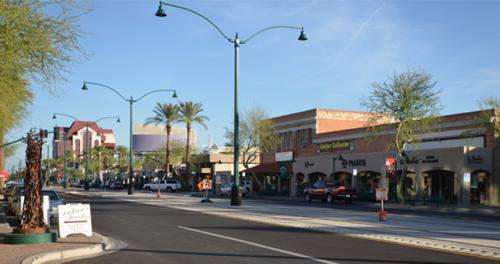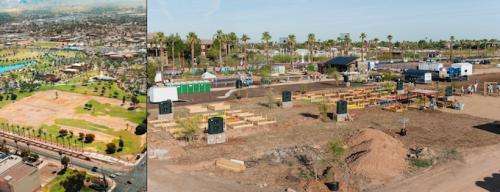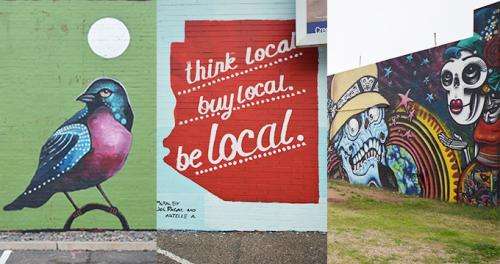A sustainable city is one that you love

Imagine walking through downtown Phoenix on a warm fall afternoon. Palm trees frame the clear blue sky as you pass brightly painted murals on the sides of buildings. The light rail passes with a friendly "ding, ding." Down the perfectly parallel, flat streets you occasionally glimpse Camelback to the east.
Cut to a stroll through downtown Seattle. The air smells of the ocean and evergreens. A hot cup of coffee warms you against the autumn chill as you walk downhill toward the bustling Pike Place Market. People haggle noisily over goods from nearby farms. Beyond the market, you catch sight of twinkling boat lights and distant, snow-capped mountains.
Every city has its own "personality." This is not only true of far-flung cities, like Phoenix and Seattle, but also of cities in close proximity, like Phoenix and Mesa. Where does a city's unique character or sense of place come from? And how can understanding sense of place help us to create more sustainable cities?
A sense of place is a city's identity knitted together from its history, the natural environment and climate, buildings and structures, art and culture, businesses and industry, and the people – both residents and visitors. A strong sense of place creates a sense of belonging and ownership for city residents, and a memorable personality for visitors. In short, it makes people care – and that might be one of the most important foundations for creating a sustainable city.
Cultural landscapes
"When cities are places, people tend to value them more," says Craig Barton, professor and director of The Design School at Arizona State University. "And the value then allows for a kind of cultural stewardship, as well as ecological stewardship. When people don't care about a place, then it's easy to see it as disposable, worthless, and to not value the cultural, environmental and political systems that are extant there."
Barton's research focuses on cultural and historical preservation through architecture and urban design, especially the relationship between African-American culture and the development of southern U.S. cities. He is interested in cultural landscapes and the sense of place they convey. We can understand a cultural landscape, Barton says, by considering the cultural practices of a place and how those practices inform the design and stewardship of the site.
"Buildings are connected to sites," says Barton, "Sites support buildings. There's a complex cultural infrastructure. So those sites are really cultural landscapes in which one can understand the building as a manifestation of cultural practices, the use of the building, its connection to the site – you can't see them as independent entities."
He notes that it is easy to understand the term "cultural landscape" as applied to sites that have historical significance or a strong ethnic identity, such as Gettysburg, Pennsylvania, or a site on the Navajo Nation. But, he adds that "any site in which there's a cultural practice evident, no matter how small, mundane or vernacular" can be understood to be a cultural landscape, such as a city neighborhood, a dog park or even a grocery store.
"Being able to understand the cultural parts of sites is what differentiates the kind of nondescript and disposable landscape, which I think everybody is tired of, and turns those sites into places," says Barton.
And a place is something that people want to protect and sustain.
"You could make a really good argument that if you have sense of place, then sustainability happens on its own," says Jeff McVay, a special project manager for the Department of Development and Sustainability at the City of Mesa. McVay received a master's degree from ASU's School Public Affairs and is a member of the ASU Sustainable Cities Network. He is currently working on the City of Mesa's downtown redevelopment efforts, and says that sense of place and sustainability are important drivers of the project.
Because many elements contribute to sense of place, it can be difficult to direct or guide it. But if sense of place is so clearly important to a city and its sustainability, what tools can be used to encourage it? One seemingly unlikely place to look is at a city's zoning regulations.
Get in the zone
Abby York, associate professor in the School of Human Evolution and Social Change, acknowledges the vanilla reputation that zoning can have but says that it doesn't get the credit it deserves.
"It's really the teeth of any kind of planning," she says. "Zoning is like the workhorse. City planners and cities conduct visioning exercises and say 'this is who we want to be,' but in order to actually do it, they use zoning. For me, it's one of the most interesting tools out there."
York's research includes the study of urbanization and the dynamics of the local political economy. She recently co-authored a paper with ASU colleagues examining zoning and land use in Phoenix from 1930 through the post-World War II era and their relationship to environmental injustice and the development of the city. Through her research she has witnessed how impassioned people can become about zoning because of the impact it has on their communities.
"Zoning isn't sexy but it's where a lot of the politics happen in communities," she says. "If you want to see people get really upset, go to some zoning meetings."
Curt Upton is a planner with the City of Phoenix who graduated from ASU's School of Geographical Sciences and Urban Planning. He is director of ReinventPHX, an initiative that guides transit-oriented development along the light rail corridor. He describes zoning as a valuable tool that enables the future a city wants to see.
"What zoning should do," he says, "is create the enabling environment for investment to come in, because the investment is what's going to change things."

The rise of suburbia
Municipal zoning was introduced into American cities in the early 20th century as a way to tame rapid and unrestricted development in response to the industrial revolution. Prior to zoning, factories and residences sprouted alongside one another with no regard for health or living conditions. Zoning regulations known as "Euclidean zoning" helped to guide development and to improve the livelihood of citizens by designating land for single use in the broad categories of industrial, commercial and residential.
Euclidean zoning encouraged the concentration of industry and commercial areas near a city's center while locating residences on the outskirts, which were quickly becoming reachable as the automobile became a typical family accessory. Phoenix's adoption of Euclidean zoning in the 1950s went hand-in-hand with creating the sprawling, car-dependent metropolis that was idealized during the time.
"The automobile and Mesa came of age together," says McVay. "And until recently, Mesa just embraced that fact."
With no shortage of land available for development, Phoenix and other Valley cities, like Mesa, welcomed the suburban utopia wholeheartedly. Tract neighborhoods marched into the desert. The exodus of residents to the suburbs also meant the diffusion of vibrancy and sense of place that would otherwise concentrate downtown.
Colin Tetreault, faculty associate at the Julie Ann Wrigley Global Institute of Sustainability and former sustainability policy adviser to the mayor of Phoenix, illustrates the lifestyle idealized during this era by describing a photograph that many of us could find in our grandparents' photo albums: "It was them sitting in front of the house on the hood of the car. You had the house in the background, the car parallel on the curb and them. That was their 'Look, we've made it!' picture. That was freedom. It was the ability to move from an urban core, to have the choice to drive to Woolworth's, not to have to take the bus or walk. And that's what society wanted for a long time."
Best laid plans
Urban cores dense with industry and ringed by far-flung residential developments aren't what society is clamoring for anymore. As they update their zoning regulations and plan for long-term development, city governments are reflecting the desire to invigorate urban cores with a mix of residences, businesses, employment opportunities and amenities.
"For a long time in planning, the map was drawn and there was a box, and that box had a color and that color said 'This is what you do there.' Those were rigid documents, and they didn't encourage the flexibility and creativity in development needed to create sense of place," says McVay. "But the planning community long ago recognized the problem with that, and have been advancing more appropriate policy and regulatory responses."
Today, cities are moving away from Euclidean zoning and using new tools that promote mixed-use urban development. Instead of separating land uses and specifying the exact types of development that can occur in an area, cities are using tools called character areas and form-based zoning codes to promote sense of place and areas of compatible mixed use.
Defining character areas prioritizes the sense of place an area should evoke while preserving flexibility. In describing a character area, emphasis is placed on the look and feel of the area, and a general description of the type of compatible development that should be encouraged is outlined.
"We describe the character that we want an area to have," McVay explains. "We don't say what land uses make that character happen."
Planning outside the box
City plans for both Phoenix and Mesa include character area descriptions. For example, Mesa's plans for redeveloping its downtown include preservation of culture and identity with a "historic downtown" character area. But it also includes establishing a new identity with a nearby "modern downtown" character area.
A form-based code supports the guidelines provided by a character area description. It details the acceptable design in each character area, from building height and materials to other urbanscape features, such as street width, medians, pedestrian access and lighting.

Using character areas and form-based codes helps to cultivate sense of place by bringing coherence to an urban area. This coherence is crucial because urban properties have a connectedness to and dependence on surrounding properties in a way that suburban properties do not.
"No one wants to buy a townhouse without the town around it," Upton says.
This interconnectedness is at the core of PHX Renews, a program that Tetreault led while with the mayor's office. PHX Renews is "transforming vacant lots into new opportunities." Unlike most cities of comparable size, Phoenix has plenty of vacant land ready for improvement, but the developers who own these parcels often have no plans for building. The city imposes little financial penalty on property owners who do not develop vacant land, and so many chose to wait. What they are waiting for, Tetreault says, is sense of place.
PHX Renews, in partnership with Keep Phoenix Beautiful, works with property owners to activate vacant lots. One example is a 15-acre parcel at the corner of Central and Indian School in downtown Phoenix. The parcel sat vacant from 1990 until 2013, when PHX Renews transformed the lot into a huge community garden.
"It doesn't have to be astrophysics to bring back some vitality to an area," says Tetreault. "If people are there, having a good time, it will be vibrant. And what if a small business pops up across the street, like a coffee shop? Well now there's a coffee shop anchoring that corner. Is that then going to help precipitate the mindset of the landowner to create a development solution? I hope so."
Ask and listen
Development that reflects the values of city residents helps to preserve sense of place and important cultural landscapes. Capturing those values means establishing good communication with citizens.
Public meetings have a reputation for being poorly attended by the people who will be affected by the plans. But increasingly, York says, cities are working to change this and to involve residents who have traditionally not had a voice. This includes holding meetings at times and places convenient to residents, providing translators if needed and communicating on the Web.

"It's meeting the people where they need to be spoken to and how they want to speak," Tetreault says. "So it's going to where the people are and listening to them. It's not holding meetings at senior centers. It's going to the schools. It's even talking to the kids."
Tetreault and Upton emphasize that great effort was made to involve residents during planning for ReinventPHX, an effort that Tetreault also worked on during his tenure with the mayor's office. Upton notes that ASU was also instrumental in the success of the community engagement.
"In our districts east of downtown we had six residents serving on steering committees advising the city who spoke no English at all," Upton says. "I'm very proud that we were able to conduct a public involvement process that not only brought in new leaders, but brought in leaders who had never had an opportunity to be involved."
During the ReinventPHX public outreach, a clear message came from citizens about what they value about Phoenix. They want to preserve diversity in all forms: ethnicity, culture and the amenities available.
"They don't want the light rail corridor to be developed where everything is just a café and a gallery and there's no daycare," Upton says. "And as planners, that's actually the good practice. We want diversity in all the things we do."
As municipal governments increasingly work to promote the character of their cities through zoning and development, and as more citizen voices take part in these processes, a city's sense of place grows richer. This in turn motivates citizens to help their city thrive for years to come.
"You're making people care more about the place, whether it's the culture or ecology of a place," says Barton. "And that contributes to the sustainability."
Provided by Arizona State University



















